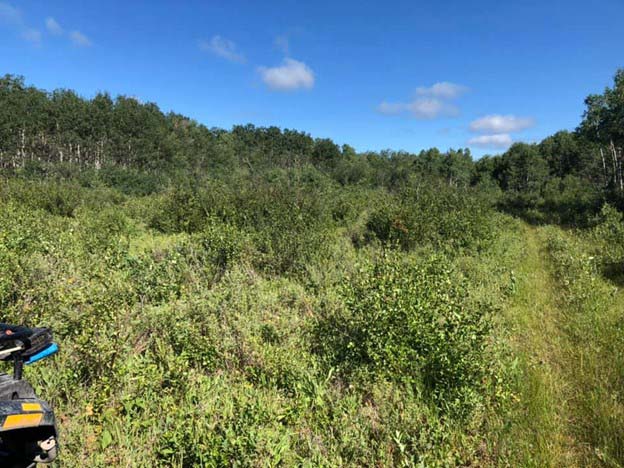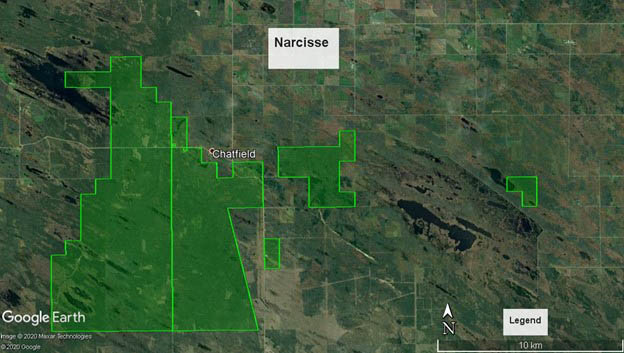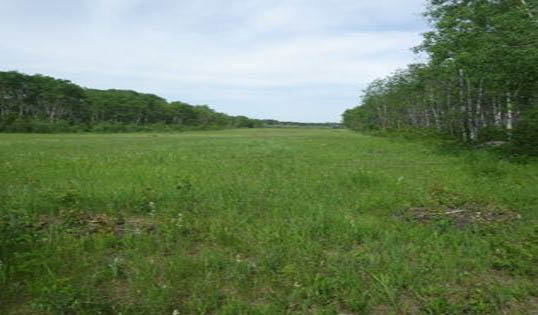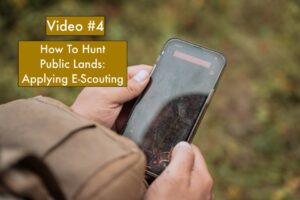
By Dennis Schindler, MWF Land and Resource Manager
Approximately 1 hour and 15 minutes north of Winnipeg, adjacent to PTH 17 in the heart of Manitoba’s Interlake Region you will find the Narcisse Wildlife Management Area. It encompasses approximately 12,000 hectares of ridge and swale topography typical of the Interlake Region.
Narcisse WMA was established in 1969 for the purpose of conserving habitat for upland game birds, waterfowl, and deer. Narcisse WMA remains home to many species of big game and upland bird species including deer, elk, sharp-tailed grouse, and ruffed grouse, and remains a popular hunting spot with excellent access off PTH 17. Through many areas of the WMA you will find limestone bedrock very close to or at the surface. Aspen-oak forest is found on the ridges, while open water and marsh vegetation dominate the swales. There are still some old white spruce stands occurring in the WMA. Prior to designation, the ridges were dominated by native grasslands and many fields are still present dating back to the time of original settlement. Slowly the native grasslands and old fields are being lost to aspen and willow encroachment without the benefit of fire or other management tools.
Since its creation and through the 1970’s walking trails, access and designated routes and all-weather access roads were created. As well during the 70’s, approximately 600 acres of the WMA were reforested with cedar, white spruce and juniper.
Due to a decline in the grouse population in 1971-72 a study was undertaken to determine factors controlling numbers, distribution, and harvest of sharp-tailed grouse.
In 1972 efforts to improve deer habitat were undertaken under the Fund for Rural Economic Development (FRED) program. This involved clearing and disking trails, seeding old fields, and establishing 345 ha (850 acres) of alfalfa, alsike clover, and intermediate wheatgrass.
Designated routes were established in 1975 to protect the area from overuse, but these routes were eventually repealed. Vehicle restrictions now only apply to the snake den site where no person shall operate a vehicle. It is also unlawful to hunt, take, kill, capture, or possess a garter snake in this area. Further work included a Snowshoe hare habitat and monitoring project and a Sharp-tail grouse habitat enhancement project in 2000-2001. A Wildlife Scientific Permit was issued to Sharp-tail’s Plus for a sharp-tailed grouse habitat enhancement and monitoring project north of the Chatfield Road.
The Narcisse WMA is most well known for the Snake Dens located adjacent to PTH 17 at the eastern edge of the WMA and remain a small but important part of the WMA. The Narcisse WMA protects the largest aggregation of red-sided garter snakes in the world. It protects the dens used by tens of thousands of red-sided garter snakes to survive the harsh winter weather. The surrounding WMA and adjacent Community Pasture provides food and shelter from predators for the snakes during the summer. The WMA has become an international attraction for researchers, documentary film makers and tourists. Up to 15,000 people have been known to visit the site in spring, with the greatest attendance on the Mother’s Day weekend in May.
Present Status of Narcisse Wildlife Management Area
As part of our site selection process for Pilot Projects for Enhanced Management in Wildlife Management Areas, a fair bit of time was spent in Narcisse determining capabilities, limitations, and risks for future management. As we carried out our assessment work this past summer, we were taken back to settlement times with the numerous stone foundations, mature home shelterbelt plantings and the many, many stone fences that lined the old fields, reverted to prairie. A sign of many years of toil in an unyielding environment for land cultivation. One cannot under estimate the limitations this land has for cropping.
We identified several issues that need to be considered in future management. As a soil specialist, it was quite clear to me that severe soil limitations existed that would impair intensive management. Soils and existing native prairie grassland species are very fragile and require care in ensuring that biodiversity is maintained and enhanced. Loss of that plant species biodiversity is something that needs to be considered. As well by their very nature these soils and plant species have been significantly impacted by the unimpeded vehicle traffic that has occurred since the removal of the vehicle use restrictions in all areas of the WMA except the snake dens adjacent to PTH 17.
Like other areas of the Prairie Parkland Region of Manitoba, wooded species (aspen and willow) encroachment poses a serious threat to prairie area biodiversity within the WMA. In the absence of control such as fire or mowing these prairie areas will be lost along with the upland bird habitat they support.
Another area of concern from a wildlife habitat and biodiversity perspective is the agricultural use that exists within the WMA. A network of hay permits are issued throughout the WMA and there is considerable concern of continuous haying, particularly in the uplands. Future agricultural use within the WMA should be governed by sound principles of multiple use with the priority on maintaining and enhancing habitat for sharp-tailed grouse and deer.
In conclusion if you can visit Narcisse at any time of year please do. It is a jewel in the Interlake, be it for hunting and other recreational pursuits, for its biodiversity and of course the snake dens. You will be glad you did.
Many thanks to the Wildlife and Fisheries Branch, Province of Manitoba for the background information provided that made this article possible.



